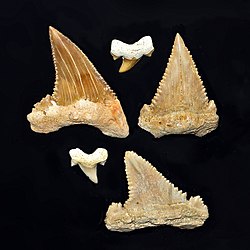| Palaeocarcharodon Temporal range: Paleocene, | |
|---|---|
 | |
| Fossil teeth of Palaeocarcharodon orientalis (the largest three) from Khouribga (Morocco), alongside teeth of Otodus | |
| Scientific classification | |
| Kingdom: | Animalia |
| Phylum: | Chordata |
| Class: | Chondrichthyes |
| Subclass: | Elasmobranchii |
| Division: | Selachii |
| Order: | Lamniformes |
| Family: | † Otodontidae |
| Genus: | † Palaeocarcharodon Casieer, 1960 |
| Species: | †P. orientalis |
| Binomial name | |
| †Palaeocarcharodon orientalis (Sinzow, 1899) | |
Palaeocarcharodon, also known as the pygmy white shark, is a genus of shark within the family Otodontidae [1] that lived about 61.7 to 55.8 Ma during the Paleocene. It currently contains a sole species P. orientalis. [2]


